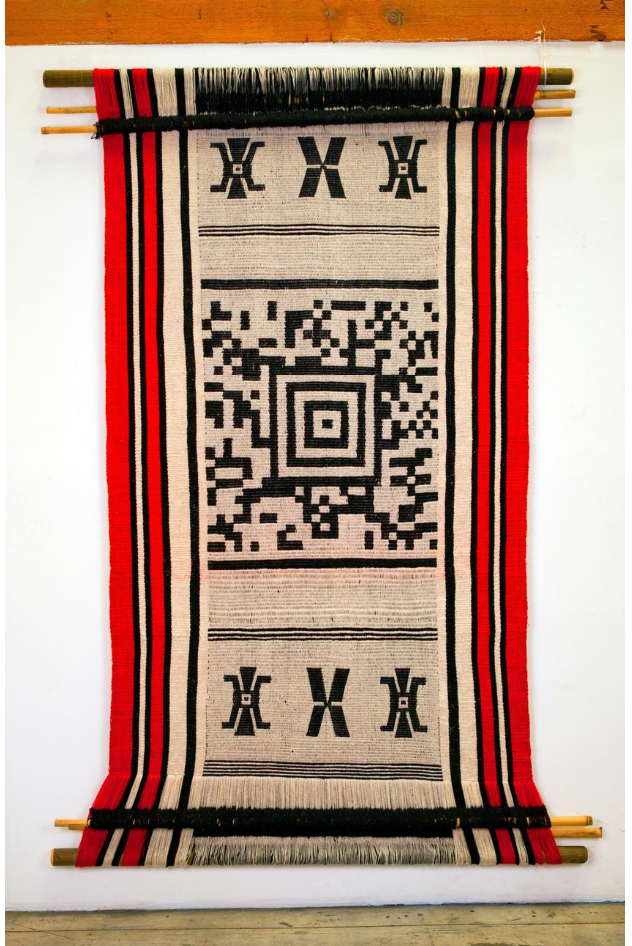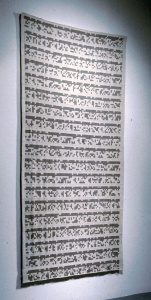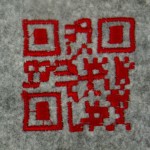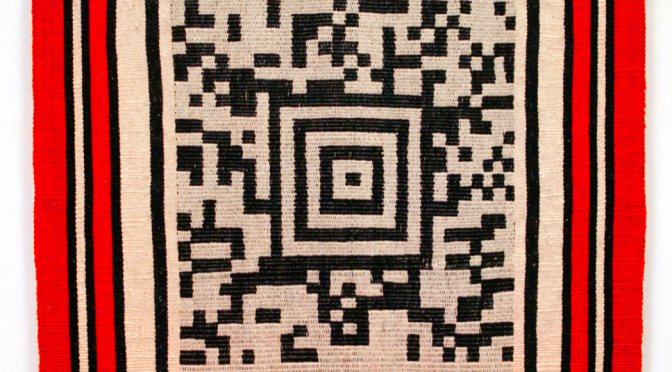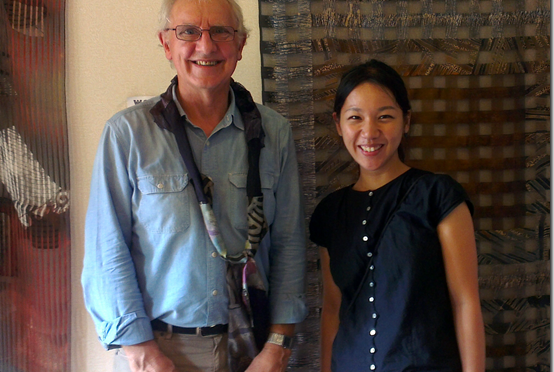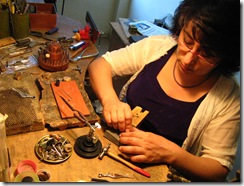
DSCF6048

DSCF6058

DSCF6049

DSCF6066
|
The UNESCO Workshop for Artisans and Designers in Santiago brought together participants from Uruguay, Argentina, Chile, Peru, Paraguay, Colombia and Brazil. For three days, we discussed the ethics of the relationship between those who make craft products and those who develop them for markets. It was a fascinating workshop for many reasons.
First, it was interesting to witness the manner in which people of diverse views come together like this in Latin America. It was very smoothly and warmly facilitated by Rafael del Campo, who used a ‘world café’ method to ensure everyone had a chance to contribute to discussions. Celina Rodriquez from Universidad Catolica helped ensure the program had a warm welcome from local artisan communities. Generally, the event was framed as a celebration of the way artisans and designers can complement each other. The participating artisans spoke very positively about the way designers enabled their careers to develop. The Chilean wood carver Hector Bascuñan described the designer that he collaborated with as an ‘angel’. But there was still plenty of opportunity to consider the tensions that exist in this relationship.
One burning issue was the ownership of intellectual property. I contributed to this inadvertedly by presenting the example of Better World Arts, the Australian organisation that brokers designs from the Kaltjiti community in the desert centre with artisans in the Kashmir and Peru, who translate their designs into rugs and jewellery. This was quite a surprising arrangement to those present. It challenged the implicit assumption that artisans can properly only make works that draw from their own culture. Much had to be explained about the Australian scene, how we lack those that might be called traditional artisans, and how it is difficult for indigenous communities to meet the demand for craft products within their own resources. It helped stimulate some very interesting discussions.
There were many who saw transnational craft as a way of the future. In the global craft ecology, continents like Latin America have the potential to provide the handmade dimension to various foreign creative industries, like product development and fashion – handbags handwoven in Bolivia, for example. But there are serious risks. In attaching the handmade component as an exotic feature, do we trivialise craft? Shouldn’t we consider craft as a whole, as the expression of culture in its own terms? But then if Bolivian artisans decide to accept a commission like this in order to simply survive, can anyone stop them?

DSCF6078

DSCF6085

DSCF6062

DSCF6082
|
I believe in the power of cultural exogamy. There are many examples of cultural exchange that strengthen tradition. Tango was only really acknowledged in Argentina once it was ‘discovered’ in Paris. It has since been adopted by cultures all around the world, with its own distinctive Scandinavian, Slavic and Japanese versions. Despite this diffusion, Buenos Aires is still revered as the home of tango.
Can the same occur in craft? There are powerful examples, like ikat weaving, raku ceramics, Venetian glass, where its adoption by other cultures has strengthened the status of its point of origin. Seeing our own cultural techniques applied in foreign contexts helps not only demonstrate their potency, but also helps identify what is distinctive to ourselves. Seeing how Australians apply raku techniques shows its potency as an expression of place but also reveals by contrast what is different about the original Japanese version
The critical issue seems to be not one of contamination, but of commodification. Capitalist production does tend to appropriate cultural signs, decontextualise them, and then sell them for the biggest profit. When purchasing products, consumers are encouraged to consider brand identity rather than its point of origin. Given the powerful capitalist neighbour to the north, it is natural you can find in Latin America a defensive position towards cultural appropriation. Rightly so. Contrast the culture of Coca Cola with its indigenous origins in the Andes. But maybe there are other kinds of partnerships beyond cultural predation.
It is here where the issue of moral rights for producers seems to play a potentially important role. So often products that feature artisan origins fail to identify exactly who made the product. We have a system of moral rights for creators to ensure that when works of art or design are copied that the author is attributed. But this doesn’t exist for producers, even if their role is critical in development.
This is not a simple issue, as was made evident during the workshop. Two participants objected to the principle of individual attribution. The Brazilian designer José Alberto Nemer from Piracema Design Laboratory presented a notion of development as a romantic engagement with place which goes beyond self-conscious individual creativity. Piraceme is a native Tupi word to describe the phenomenon when fish return to their point of origin in order to spawn. This spirit of place should belong to no one individual. For different reasons, Pablo Bonaparte from the National Market of Traditional Artisans in Argentina also argued against individual ownership. For him, craft traditions are a communal entity and any attempt to sell this on the open market for individual gain would be a kind of betrayal.
While these were not the views of the majority, they were important points to consider. For Australians, this concept of collective ownership resonates with our acknowledgement that indigenous culture is a matter of custodianship. No one individual owns the designs or knowledge of Aboriginal communities. But there is a difference. Within limits, we also acknowledge the freedom of any individual indigenous artist to employ their designs as they see fit – even if woven in another country. Any attempt to resist that on the grounds of heritage would seem patriarchal, motivated more by whitefella romance that indigenous realities.
The UNESCO representative Frederic Vacheron reflected on this tension between communal heritage and individual creativity. Protection exists for both cultural heritage and individual copyright, but they can sometimes be in opposition to each other. Vacheron was confident that they could eventually be aligned, but it would take more than one workshop to do so.
In his concluding comments, Vacheron said that it was important to consider patrimony a living phenomenon, not something that needs to be isolated from the world for its survival. He said it was important to look at what was happening in Australia as an example of how traditional craft practices might find new opportunities in a globalised world. Likewise, we in Australia need to consider the Latin American views if we are to draw on their traditions to revitalise our own culture.
Along with many nations in the ‘collective west’, Australia is on a return journey back from dizzy heights of globalisation to its own piece of solid ground. As our craft skills decline, we become more dependent on artisans in other countries to provide the handmade quality that helps realise the human dimension in our designs. But can we outsource craft in the same way we have our shirts sewn anonymously in China? For the handmade to have meaning it needs a real connection with its maker. We need to know something about who made it, where their skill comes from, what they benefit in making it, and how they would like us to care for their result.
In getting to know artisans better, we can also discover something about ourselves too. What is the status of indigenous culture in their politics? How do they deal with the challenges of climate change? In what way do they respond to the cultural dominance of the north?
I certainly got to know the Latin American journey(s) a little better after this workshop. The status of being a ‘third world’ creates a sense of vulnerability to the more powerful economies particularly to the north. To northern economies, local cultural traditions are often seen as signs of backwardness. Many in Latin America thus try to present an alternative measure of value. For them, a sense of one’s own culture is more precious than the flows of capital that course through world markets. An organisations like UNESCO, which recognise the value of cultural diversity, are held in particularly high regard here. Nevertheless, financial poverty brings its own problems. So how can culture be aligned with the needs of the market without destroying its value?
It’s plain that we need to work together if we are to use globalisation as a force for good, not evil. As Jean-Jacques Rousseau said, ‘If you cannot prevent your enemies from swallowing you, at least you can prevent them from digesting you.’ So it is with cultural appropriation. It will happen. It has the capacity to aerate and enrich our cultural traditions. But we need to be prepared to prevent it also dissolving embodied cultural meanings into mere products for consumption. The workshop was a very encouraging first step in this preparation, but there is much work ahead.
We need now to invite other voices into this conversation, particularly from Africa and Asia. UNESCO is in the unique position to carry this dialogue further. But there are others, like the World Craft Council and International Design Alliance (particularly the Indigo project), who can play an important role. The workshop next month in Fiji is another step towards extending this dialogue. Throughout this process, the development of an international code of practice for craft-design collaborations is one concrete way to ensure we keep talking with each other.
